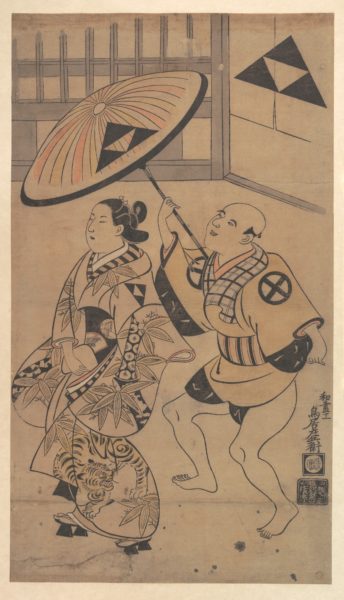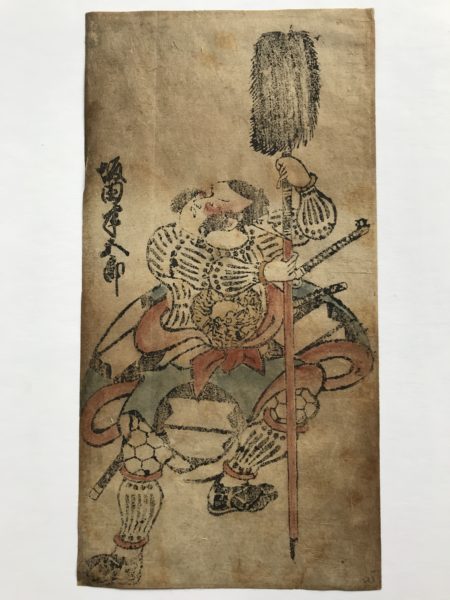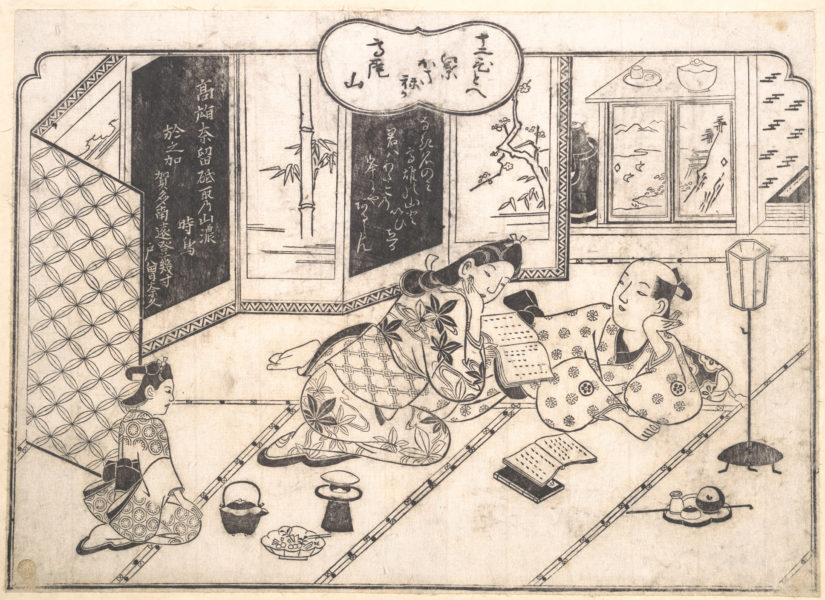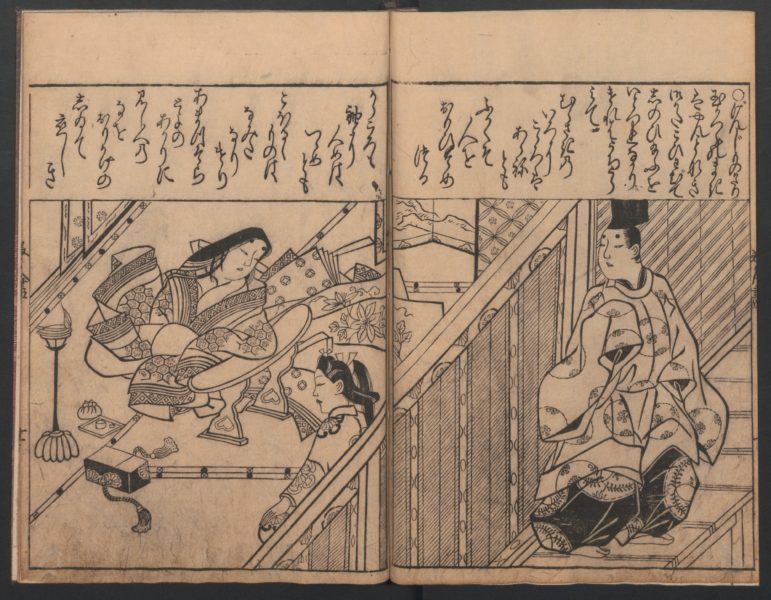Prints in the years from the 1730s through the 1750s – General By the 1730s, hand-coloured tane prints, actually last seen in 1723, definitely belong to the past. By then, until the early 1750s, or more precisely until 1752, as far as we know, equally hand-coloured lacquer prints, urushie, are the standard. But we are not there yet, benizurie (紅摺繪), prints mostly featuring printed, yes printed, crimson red and green, make their appearance from 1744 as yet another development in printing.
But there is more. Another innovation is the ‘pillar print,’ hashirae (柱繪), the ‘invention’ of which is often attributed to Okumura Masanobu, sometime in the 1740s – but the earliest datable example is from 1736, and not by Masanobu, making it more likely that it would be the publisher Urokogataya who deserves to be credited with this innovation.[1] They are narrow upright prints, their literal translation being ‘pillar prints,’ after ‘pillar’ hashira, and ‘print’ e. For quite some time it was the believe that these served as a cheap alternative for people who couldn’t afford paintings, instead pasting such a print on some pillar in the house. This is difficult to verify, as it would be quite exceptional to find just some reliable pictorial evidence for this (erotic albums offer the best chance for interior scenes, but their overall reliability is questionable). There is at least one example of a hashirae print mounted as if it were a painting and even seen hung from the hashira in an interior, but it must be said that this concerns a hashirae designed by Harunobu, moreover figuring in a Harunobu print, and thus dating from much later, the late 1760s, so this couldn’t say anything about the reason why they were developed originally.
On the other hand, we sometimes encounter hashirae prints in some cheap paper mounting, not the silks and brocades used normally in the mounting of paintings, and indeed, these mostly date from later periods. Still, there may be, of course, some truth in the idea that hashirae served as some kind of alternative for paintings, for some, at least. Even so, why would it be an alternative. It may just as well be that people buying hashirae simply didn’t even consider buying a painting. Looking at what hashirae generally show, it is mostly women at various engagements, holding an umbrella, playing with a cat, reading a letter, or an oiran with her trainee, or women alighting from the bath and clad in just a yukata and being greeted by a gentle breeze so their legs are exposed, and then there are also some occasional actors in role. Especially the women are often represented much more loosely than we would find them in the paintings of the time, where impressive portraits of high-ranking courtesans are rather favoured, and thus catering to an altogether different clientele.
Yet another new development is the ‘perspective print,’ ukie (浮繪), a concept first conceived in around 1739, the earliest known example being an anonymous painting after the play Tokiwagi Taiheiki (瑞樹太平記), staged XI/1739 at the Ichimura Theatre (KN 2:306).[1] Then we know of a print by Okumura Masanobu after a performance in III/1739 of the play Hatsu motoyuitsū Soga (初鬠通曽我), staged at the Ichimura Theatre (KN 2:303). From then on, they become something like a sub-genre of prints. Indeed, although these must have been a completely different way of viewing a two-dimensional representation of a three-dimensional reality, and totally ignoring a centuries old tradition going back to big brother China, these prints that applied a Western linear perspective instead, with a clear vanishing point on the horizon, seem to have taken Japan by storm.[3] The reason for this can only have been a broad interest in the world outside Japan. These prints are mostly of a quite large size and designed to be displayed by street performers in an apparatus known as a karakuri, or even called an Oranda ōkarakuri, allowing some persons to view these prints through a lens that would even increase the idea of a three-dimensional reality – somewhat like the virtual reality eye masks of today (more below). Yet, ukie only become something like a general commodity from the late 1760s when Utagawa Toyoharu (1735-1814, act. 1769-1805) starts making these his specialty.
Generally speaking, we see a clear increase in numbers, both of single prints and of picture books, but, as we will come to see, there is nothing like a constant increase and even the 1750s is still a rather quiet period, certainly when compared with the final decades of the eighteenth century. For the 1730s, we can identify 109 datable single prints, for the 1740s these would be 162, and for the 1750s the number is back at 99 – or, multiplied by 3.5 these figures are 381, 567, and 346, in other words 38, 56, or 34 single prints per year. And even if we multiply by a factor 5, this would still come down to an annual production of 54, 81, and 49 prints, or still not more than twice these figures if we would multiply by ten. Indeed, the real bustle is still to come and, probably, that shouldn’t surprise us – we are still looking at a rather recent phenomenon. This all started coming off the ground from the 1670s only, that is just a little less than a century ago. Moreover, still no Floating World in sight.
I seem to remember to have read that one of the Kyōhō period decrees on publishing, issued from VII/1721 through II/1723, concerned the format of prints, banning the real large formats (but cannot locate it at the moment). Anyway, indeed, from 1721, I cannot find any datable examples that are larger than the hosoban format that consequently becomes the one and only standard. Only from 1736, we find larger formats again, in the special cases of pillar prints and perspective prints.
[1] Masanobu was obviously quite good at self-promotion, and he might well be the originator of hashirae as he claims, but only very few of his pillar prints represent actors in role that could be dated, as will be demonstrated in the following.
[2] The painting is illustrated in Kishi Fumikazu, Edo no enkinbō. Tokyo: Keisō Shobō, 1994, ill. 1.
[3] The traditional concept is that what is far away, is seen in the top of a landscape painting, what is closer-by is seen in the centre of a painting, and what is nearby is seen in the bottom of a painting.




